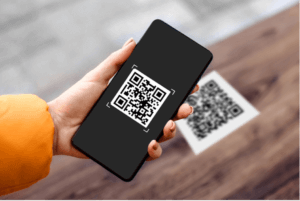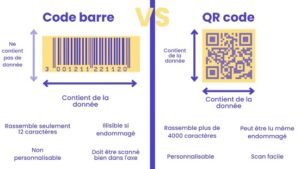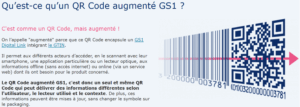[vc_row][vc_column][vc_column_text]
The history of the QR Code
The QR code (quick response code) was created in 1994 by Japanese engineer Masahiro Hara. It was initially designed to follow the itinerary of spare parts in Toyota factory warehouses. Five years later, it was released under a free license, enabling it to be used by a wider public for a variety of purposes. It consists of a two-dimensional barcode. The latter is made up of black square-modules in a square with a white background, which define the information contained in the code.

Bar code vs. QR code: why this opposition?
The barcode revolutionized the world of retailing as soon as it came onto the market in the late 70s. In his book Uneéconomie mondiale en 50 inventions , economist and Financial Times journalist Tim Harford draws a correlation between the explosion of mass retailing and the widespread introduction of the barcode. In particular, the globalization of the barcode considerably reduced checkout times.
Bar codes are generally used for identification purposes. The most common uses are :
- Tracking of parcels and/or registered letters.
- Baggage tracking on airlines.
- Patient and drug identification.
- Document indexing.

QR codes have become a permanent fixture in many industries in recent years, for a variety of reasons. As the customer experience is becoming increasingly mobile-friendly, QR codes are being used more and more, to the detriment of barcodes for their ease of scanning. In a world where data is at the heart of everything, systems that can store as much of it as possible, and process it without difficulty, are highly sought-after.
The QR code has this considerable advantage. Indeed, as Cécile Dard points out in her article Le QR code remplace les code-barres, ce que ça change pour vous: "(...) un code-barres contient 13 informations quand un QR Code en propose 400!". The main example is the grouping of information on product traceability, which is now imposed by the AGEC law for clothing and the consumer code for food.
As related in our article The fabulous destiny of the QR code QR codes also stood out during the Covid-19 epidemic. To limit contact and prevent the spread of the virus, it was used extensively to read restaurant menus and health passes in France.
What about the future of QR codes?
The QR code's flexibility and speed of execution mean that it is now widely used and preferred for rapid access to information. Retailers such as Grand Frais have already begun testing the use of QR codes on their products. The heads of GS1 (Global Standard 1), the organization that sets standards for coding consumer goods worldwide, have announced that by 2027, the barcode will gradually disappear, to be replaced by an " augmented QR Code ".
The reason? The ability of the latter to contain more information than the traditional barcode. This demand is the result of changing consumption patterns and consumer demands.

Despite the limitations of the barcode, it remains a safe bet in the retail sector. Despite its widespread use, the QR code is still fragile in terms of its ability to protect the data it carries. Francenum (a government initiative in charge of the digital transformation of small and medium-sized businesses), raised awareness of the steps to take to guard against attacks.
Between now and 2027, it remains important to observe the evolution of the QR code, its uses and its limits. It will also be necessary, once the code has been implemented on a large scale, to continue this observation, which will confirm or invalidate the QR code's claim to be the new barcode.
By Cira Diagana
[/vc_column_text][/vc_column][/vc_row][vc_row][vc_column][vc_column_text]Sources :
Wikipedia : QR Code
Le Monde : The QR code should gradually replace the bar code
[/vc_column_text][/vc_column][/vc_row]

